omeka
Item set
- Title
- omeka
- Description
- All items
Items
-

-

-

-
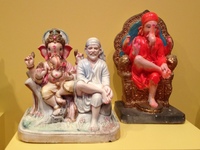
-
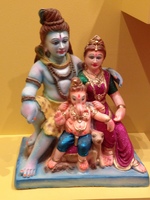
-
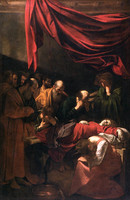
-
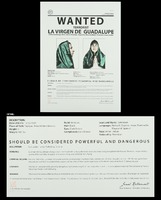 Wanted was created by Ester Hernandez in response to anti-immigration issues and racial profiling laws in Arizona. In the print, Hernandez pictures and describes the Virgin of Guadalupe as a criminal. Her crimes are described as helping people illegally immigrate into America and comforting them in at their time of death, “especially in the desert areas near the U.S./Mexico border.” Other descriptions allude to the Virgin of Guadalupe’s religious characteristics, such as an emanating glow and an angel by her side, yet places them in terms of criminality. Even the headline of “terrorist” and “powerful and dangerous” at first glance highlights the contradictory elements and ironic tone of the print. Under the description, the Virgin of Guadalupe is described to be of Amer-Indian race and American nationality. This underlines one of the causes for the print, the law in which a person may be stopped by police and asked for immigration papers just because the color of their skin gives them stereotyped suspicion. The Virgin of Guadalupe is used as a representation of those targeted by these laws and accents the wrong of such practices because of how she epitomizes innocence. By using the Virgin of Guadalupe on a wanted poster, the viewer is able to conceptualize the injustice to which the artist speaks. The religious figure of the Virgin of Guadalupe has been remade to expand from the role of a comforting mother, but as a representation of persecuted people. As a wanted outsider in her own country, according to the print’s description, the Virgin of Guadalupe portrays the victimized spirit of her followers yet also propels her role forward as being one who comforts and shows resilience.
Wanted was created by Ester Hernandez in response to anti-immigration issues and racial profiling laws in Arizona. In the print, Hernandez pictures and describes the Virgin of Guadalupe as a criminal. Her crimes are described as helping people illegally immigrate into America and comforting them in at their time of death, “especially in the desert areas near the U.S./Mexico border.” Other descriptions allude to the Virgin of Guadalupe’s religious characteristics, such as an emanating glow and an angel by her side, yet places them in terms of criminality. Even the headline of “terrorist” and “powerful and dangerous” at first glance highlights the contradictory elements and ironic tone of the print. Under the description, the Virgin of Guadalupe is described to be of Amer-Indian race and American nationality. This underlines one of the causes for the print, the law in which a person may be stopped by police and asked for immigration papers just because the color of their skin gives them stereotyped suspicion. The Virgin of Guadalupe is used as a representation of those targeted by these laws and accents the wrong of such practices because of how she epitomizes innocence. By using the Virgin of Guadalupe on a wanted poster, the viewer is able to conceptualize the injustice to which the artist speaks. The religious figure of the Virgin of Guadalupe has been remade to expand from the role of a comforting mother, but as a representation of persecuted people. As a wanted outsider in her own country, according to the print’s description, the Virgin of Guadalupe portrays the victimized spirit of her followers yet also propels her role forward as being one who comforts and shows resilience. -
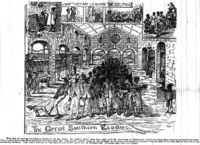 “The Great Southern Exodus” was drawn by Henry J. Lewis for the Indianapolis Freeman. It depicts smaller scenes pictured above a larger scene, the smaller ones commenting on reasons for the larger. The large scene in the picture is that of a crowd of African Americans marching forward in a train station, train present in the left of the photo. In the upper left corner is a drawing of an African American in a real estate office to buy land, the caption under it reads “The Negro in Kansas.” This contrasts with the drawing in the upper right corner of an African American “in Dixie’s Land” playing the banjo for dancing white women. The drawing in Kansas, which was outside of the southern states, represents how an African American can become independent and prosper by owning his own land. The opposite is shown in Dixie where the African American is at the service of the white population. In the top center, under the caption “Why they are leaving the south,” are pictures of African Americans being whipped, lynched, and chased by dogs. These portrayals highlight the cruelty of slavery they wish to escape. The setting of the train station is important in meaning as it conveys the train as being a way of access to the north. The migration of African Americans from the south to the north, fleeing the land of slavery, parallels that of the departure of the Israelites in The Exodus. The drawing comments on this through its title and makes the viewer understand significant likeness between the Bible and the African American migration.
“The Great Southern Exodus” was drawn by Henry J. Lewis for the Indianapolis Freeman. It depicts smaller scenes pictured above a larger scene, the smaller ones commenting on reasons for the larger. The large scene in the picture is that of a crowd of African Americans marching forward in a train station, train present in the left of the photo. In the upper left corner is a drawing of an African American in a real estate office to buy land, the caption under it reads “The Negro in Kansas.” This contrasts with the drawing in the upper right corner of an African American “in Dixie’s Land” playing the banjo for dancing white women. The drawing in Kansas, which was outside of the southern states, represents how an African American can become independent and prosper by owning his own land. The opposite is shown in Dixie where the African American is at the service of the white population. In the top center, under the caption “Why they are leaving the south,” are pictures of African Americans being whipped, lynched, and chased by dogs. These portrayals highlight the cruelty of slavery they wish to escape. The setting of the train station is important in meaning as it conveys the train as being a way of access to the north. The migration of African Americans from the south to the north, fleeing the land of slavery, parallels that of the departure of the Israelites in The Exodus. The drawing comments on this through its title and makes the viewer understand significant likeness between the Bible and the African American migration. -
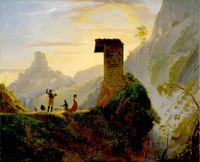 The Chapel of the Virgin at Subaico was created by the American Protestant Samuel F.B. Morse. It portray peasants, including a woman worshipping on her knees, at a shrine of the Virgin along the countryside somewhere east of Rome. The shrine is located at the edge of a cliff, isolating it from the others hills in the background. The image looks on the viewers at a distance, unable to clearly see their faces. Any depiction of the virgin, that being the subject of worship in the scene depicted, in not visible to the viewer. These qualities of the image reflect attitudes felt by the artist, being a Protestant painting a Catholic scene of worship to an icon. The limitations of facial clarity, isolation, and absence of the icon set up the convictions a Protestant would feel toward the mysteries of a Catholic worship. By being an outsider to the religion himself, Morse creates an image where the viewer, too, feels like an outsider, unable to get a full grasp of everything occurring in the scene. The isolation of a distant cliff invokes the sense that the viewer is unable to access the shrine like the subjects of the painting. The sun being behind the scene creates more shadow, darkening what can be seen than if the sun had been shining behind the viewer. This contributes to the idea of Catholic worship being incompletely understood by American Protestants. The shadow and inclarity of faces also causes a lack of empathy for the viewer towards the worshipping subjects. One viewing this image is left with a similar attitude as that of the artist.
The Chapel of the Virgin at Subaico was created by the American Protestant Samuel F.B. Morse. It portray peasants, including a woman worshipping on her knees, at a shrine of the Virgin along the countryside somewhere east of Rome. The shrine is located at the edge of a cliff, isolating it from the others hills in the background. The image looks on the viewers at a distance, unable to clearly see their faces. Any depiction of the virgin, that being the subject of worship in the scene depicted, in not visible to the viewer. These qualities of the image reflect attitudes felt by the artist, being a Protestant painting a Catholic scene of worship to an icon. The limitations of facial clarity, isolation, and absence of the icon set up the convictions a Protestant would feel toward the mysteries of a Catholic worship. By being an outsider to the religion himself, Morse creates an image where the viewer, too, feels like an outsider, unable to get a full grasp of everything occurring in the scene. The isolation of a distant cliff invokes the sense that the viewer is unable to access the shrine like the subjects of the painting. The sun being behind the scene creates more shadow, darkening what can be seen than if the sun had been shining behind the viewer. This contributes to the idea of Catholic worship being incompletely understood by American Protestants. The shadow and inclarity of faces also causes a lack of empathy for the viewer towards the worshipping subjects. One viewing this image is left with a similar attitude as that of the artist. -
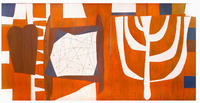 The oil on Masonite mural titled “The Wall of the Temple” was created by the Abstract Expressionist artist Robert Motherwell in 1952. Motherwell was at the forefront of the American modern art movement, and was well known for his avant-garde work. Although Motherwell was not Jewish, he studied with Columbia University professor and Rabbi Meyer Schapiro and had spiritual themes within his work. Motherwell was commissioned by architect Percival Goodman to create a contemporary piece of art for the lobby of a modern synagogue in Millburn, New Jersey. Goodman designed a synagogue that was modern and not based off of traditional Jewish architecture with the intent of creating a space that was not only for worshipping purposes, but also was a space where Jews could find a sense of community and culture. Many American Jews had moved out of city and into the suburbs post WWII and no longer were apart of close knit Jewish neighborhoods. Creating a “modern” synagogue that included abstract art was considered a bold move during this time period. The modern synagogue provided a place for American Jews to socialize instead of being strictly for religious purposes. The large mural painting displays abstract representations of Jewish symbols such as Jacob’s ladder, the tablets of Moses, and the Diaspora of the Twelve Tribes of Israel. In 2010, the mural went on display at the Jewish Museum in the New York City as part of an exhibition titled “Modern Art, Sacred Space: Motherwell, Ferber, and Gottlieb”.
The oil on Masonite mural titled “The Wall of the Temple” was created by the Abstract Expressionist artist Robert Motherwell in 1952. Motherwell was at the forefront of the American modern art movement, and was well known for his avant-garde work. Although Motherwell was not Jewish, he studied with Columbia University professor and Rabbi Meyer Schapiro and had spiritual themes within his work. Motherwell was commissioned by architect Percival Goodman to create a contemporary piece of art for the lobby of a modern synagogue in Millburn, New Jersey. Goodman designed a synagogue that was modern and not based off of traditional Jewish architecture with the intent of creating a space that was not only for worshipping purposes, but also was a space where Jews could find a sense of community and culture. Many American Jews had moved out of city and into the suburbs post WWII and no longer were apart of close knit Jewish neighborhoods. Creating a “modern” synagogue that included abstract art was considered a bold move during this time period. The modern synagogue provided a place for American Jews to socialize instead of being strictly for religious purposes. The large mural painting displays abstract representations of Jewish symbols such as Jacob’s ladder, the tablets of Moses, and the Diaspora of the Twelve Tribes of Israel. In 2010, the mural went on display at the Jewish Museum in the New York City as part of an exhibition titled “Modern Art, Sacred Space: Motherwell, Ferber, and Gottlieb”. -
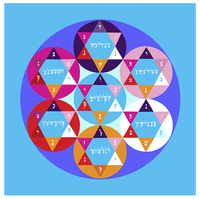
-
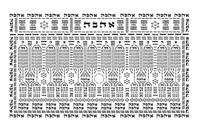 A shivti is classically used to prepare an individual for prayer and meditation by focusing their mind and heart. This shivti is inscribed solely by the word Ahava, which means love.
A shivti is classically used to prepare an individual for prayer and meditation by focusing their mind and heart. This shivti is inscribed solely by the word Ahava, which means love. -
 The artist represents all the 100 blasts of the Shofar that are heard on the High Holy Days as triangles.
The artist represents all the 100 blasts of the Shofar that are heard on the High Holy Days as triangles. -
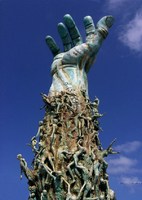 The sculpture titled “The Sculpture of Love and Anguish” is part of the Miami Beach Holocaust memorial. The 42 foot high bronze hand was created by Kenneth Treister, who dedicates the memorial to the 6 million people who lost their lives in the holocaust. It took Treister five years to finish the sculpture. Giant blocks of pink-hued Jerusalem stone imported from Israel were used for the foundation and the sculpture was cast in Mexico City. Treister intended to create the sculpture as part of “a series of outdoor spaces in which the visitor is led through a procession of visual, historical, and emotional experiences with the hope that the totality of the visit will express, in some small way, the reality of the Holocaust.” The ultimate purpose of this memorial is to remember the tragic events of the holocaust and the individual lives that were taken, as well as the rich culture that was destroyed. The sculpture portrays an extended arm reaching towards the sky with hundreds of naked bodies helping others hold on, while struggling to climb up the arm and make it to the top. The sculpture represents a final act of love by family members, who have suffered immensely due to the atrocities of the holocaust. Even after they have been dehumanized the victims continue to show love for their family members, as their weak and fragile bodies struggle to hold on to the arm reaching towards heaven.
The sculpture titled “The Sculpture of Love and Anguish” is part of the Miami Beach Holocaust memorial. The 42 foot high bronze hand was created by Kenneth Treister, who dedicates the memorial to the 6 million people who lost their lives in the holocaust. It took Treister five years to finish the sculpture. Giant blocks of pink-hued Jerusalem stone imported from Israel were used for the foundation and the sculpture was cast in Mexico City. Treister intended to create the sculpture as part of “a series of outdoor spaces in which the visitor is led through a procession of visual, historical, and emotional experiences with the hope that the totality of the visit will express, in some small way, the reality of the Holocaust.” The ultimate purpose of this memorial is to remember the tragic events of the holocaust and the individual lives that were taken, as well as the rich culture that was destroyed. The sculpture portrays an extended arm reaching towards the sky with hundreds of naked bodies helping others hold on, while struggling to climb up the arm and make it to the top. The sculpture represents a final act of love by family members, who have suffered immensely due to the atrocities of the holocaust. Even after they have been dehumanized the victims continue to show love for their family members, as their weak and fragile bodies struggle to hold on to the arm reaching towards heaven. -
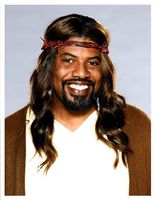 Black Jesus is the title character in a current Adult Swim satiric television show, played by Gerald "Slink" Johnson.
Black Jesus is the title character in a current Adult Swim satiric television show, played by Gerald "Slink" Johnson. -
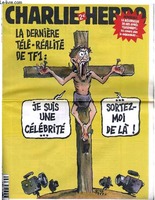
-
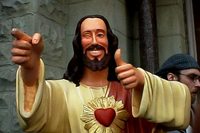 Buddy Christ is a statue of Jesus used in the 1999 Catholic satire film, "Dogma."
Buddy Christ is a statue of Jesus used in the 1999 Catholic satire film, "Dogma." -
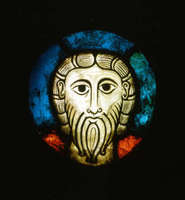
-
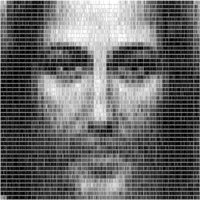 Barcode Jesus is a piece of artwork created by Scott Blake entirely out of SKU codes.
Barcode Jesus is a piece of artwork created by Scott Blake entirely out of SKU codes. -
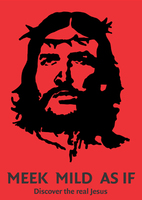 "Meek. Mild. As If." is an advertisement created and distributed in the UK to draw worshippers to Easter church services. The Churches Advertising Network created the ad.
"Meek. Mild. As If." is an advertisement created and distributed in the UK to draw worshippers to Easter church services. The Churches Advertising Network created the ad. -
 R1840 Name: Pyroxenite Location: Nye, Montana Geologic Age: Precambrian Geologic name: Stillwater complex Megascopic Description: A dark gray rock with a most commonly rough granular texture. It is largely composed of orthopyroxene (bronzite) and has a glassy appearance. Microscopic Description: The rounded olivine is criss-crossed by thin brownish serpentine veinlets. Anhedral enstatite show fine grating exsolution structure vienlets. Interstitial anhedral calcic plagioclase and clumps of subrounded chromite grains are accessories. Small amounts of clinopyroxene may be present in some sections.
R1840 Name: Pyroxenite Location: Nye, Montana Geologic Age: Precambrian Geologic name: Stillwater complex Megascopic Description: A dark gray rock with a most commonly rough granular texture. It is largely composed of orthopyroxene (bronzite) and has a glassy appearance. Microscopic Description: The rounded olivine is criss-crossed by thin brownish serpentine veinlets. Anhedral enstatite show fine grating exsolution structure vienlets. Interstitial anhedral calcic plagioclase and clumps of subrounded chromite grains are accessories. Small amounts of clinopyroxene may be present in some sections. -
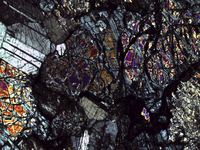 During stage three of crystallization there is 71% Olivine crystals and 29% Plagioclase feldspar crystals
During stage three of crystallization there is 71% Olivine crystals and 29% Plagioclase feldspar crystals -
A.B. Engineering program name changed to Engineering Studies
-
Fall 1970: The college offered for the first time a major in engineering in the A.B. program. It was intended to be 'a flexible program, incorporating the recommended liberal education course of the AB degree program and the technical studies of the engineering program
